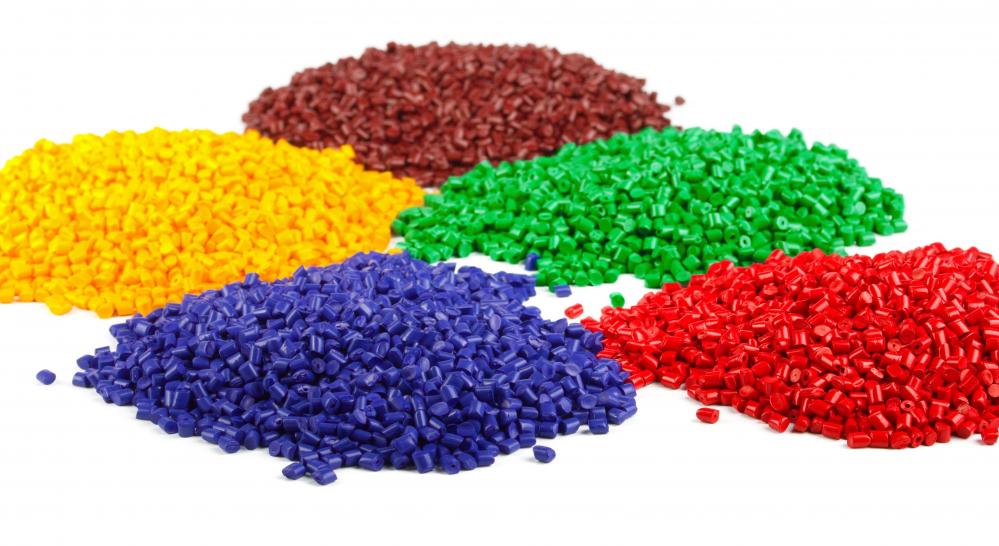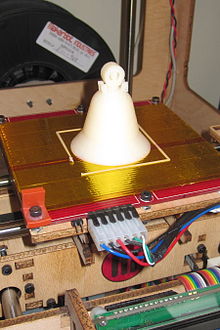
Acrylonitrile butadiene styrene (ABS) (chemical formula (C8H8)x· (C4H6)y·(C3H3N)z) is a common thermoplastic polymer. Its glass transition temperature is approximately 105 °C (221 °F).[2] ABS is amorphous and therefore has no true melting point.
ABS is a terpolymer made by polymerizing styrene and acrylonitrile in the presence of polybutadiene. The proportions can vary from 15 to 35% acrylonitrile, 5 to 30% butadiene and 40 to 60% styrene. The result is a long chain of polybutadiene criss-crossed with shorter chains of poly(styrene-co-acrylonitrile). The nitrile groups from neighboring chains, being polar, attract each other and bind the chains together, making ABS stronger than pure polystyrene. The styrene gives the plastic a shiny, impervious surface. The polybutadiene, a rubbery substance, provides toughness even at low temperatures. For the majority of applications, ABS can be used between −20 and 80 °C (−4 and 176 °F) as its mechanical properties vary with temperature.[3] The properties are created byrubber toughening, where fine particles of elastomer are distributed throughout the rigid matrix.
Properties[edit]
The most important mechanical properties of ABS are impact resistance and toughness. A variety of modifications can be made to improve impact resistance, toughness, and heat resistance. The impact resistance can be amplified by increasing the proportions of polybutadiene in relation to styrene and also acrylonitrile, although this causes changes in other properties. Impact resistance does not fall off rapidly at lower temperatures. Stability under load is excellent with limited loads. Thus, by changing the proportions of its components, ABS can be prepared in different grades. Two major categories could be ABS for extrusion and ABS for injection moulding, then high and medium impact resistance. Generally ABS would have useful characteristics within a temperature range from −20 to 80 °C (−4 to 176 °F).[3]
The final properties will be influenced to some extent by the conditions under which the material is processed to the final product. For example, molding at a high temperature improves the gloss and heat resistance of the product whereas the highest impact resistance and strength are obtained by molding at low temperature. Fibers (usually glass fibers) and additives can be mixed in theresin pellets to make the final product strong and raise the operating range to as high as 80 °C (176 °F). Pigments can also be added, as the raw material original color is translucent ivory to white. The aging characteristics of the polymers are largely influenced by the polybutadiene content, and it is normal to include antioxidants in the composition. Other factors include exposure to ultraviolet radiation, for which additives are also available to protect against.
ABS polymers are resistant to aqueous acids, alkalis, concentrated hydrochloric and phosphoric acids, alcohols and animal, vegetable and mineral oils, but they are swollen by glacial acetic acid, carbon tetrachloride and aromatic hydrocarbons and are attacked by concentrated sulfuric and nitric acids. They are soluble in esters, ketones, ethylene dichloride and acetone.[5]
Even though ABS plastics are used largely for mechanical purposes, they also have electrical properties that are fairly constant over a wide range of frequencies. These properties are little affected by temperature and atmospheric humidity in the acceptableoperating range of temperatures.[6]
ABS is flammable when it is exposed to high temperatures, such as a wood fire. It will melt then boil, at which point the vapors burst into intense, hot flames. Since pure ABS contains no halogens, its combustion does not typically produce any persistent organic pollutants, and the most toxic products of its combustion or pyrolysis are carbon monoxide and hydrogen cyanide.[7] ABS is also damaged by sunlight. This caused one of the most widespread and expensive automobile recalls in US history due to the degradation of the seatbelt release buttons.[8]
ABS can be recycled, although it is not accepted by all recycling facilities.[9][10]
Production[edit]
ABS is derived from acrylonitrile, butadiene, and styrene. Acrylonitrile is a synthetic monomer produced from propylene and ammonia; butadiene is a petroleum hydrocarbon obtained from the C4 fraction of steam cracking; styrene monomer is made by dehydrogenation ofethyl benzene — a hydrocarbon obtained in the reaction of ethylene and benzene.
ABS combines the strength and rigidity of acrylonitrile and styrene polymers with the toughness of polybutadiene rubber. While the cost of producing ABS is roughly twice the cost of producing polystyrene, it is considered superior for its hardness, gloss, toughness, and electrical insulation properties.
According to the European plastic trade association PlasticsEurope, industrial production of 1 kg (2.2 lb) of ABS resin in Europe uses an average of 95.34 MJ (26.48 kW·h) and is derived from natural gas and petroleum.[11]
Applications[edit]

Natural colored ABS 3D Printed Bell on a
3D printer.
ABS's light weight and ability to be injection molded and extruded make it useful in manufacturing products such as drain-waste-vent (DWV) pipe systems, musical instruments (recorders, plastic clarinets, and piano movements), golf club heads (because of its good shock absorbance), automotive trim components, automotive bumper bars, medical devices for blood access, enclosures for electrical and electronic assemblies, protective headgear, whitewater canoes, buffer edging for furniture and joinery panels, luggage and protective carrying cases, small kitchen appliances, and toys, including Lego and Kre-O bricks.[12] Household and consumer goods are the major applications of ABS.[13] Keyboard keycaps are commonly made out of ABS.[14]
ABS plastic ground down to an average diameter of less than 1 micrometer is used as the colorant in some tattoo inks.[15] Tattoo inks that use ABS are extremely vivid.[citation needed]
Hazard for humans[edit]
ABS is generally a low-hazard material and presents few risks to health.[citation needed] However, in some situations, precautions are advisable:
- Heating ABS during molding, extrusion. and 3D Printing produces fumes of poisonous acrylonitrile. Acrylonitrile may be a humancarcinogen. Butadiene is a known carcinogen. Styrene is also believed to have carcinogenic properties.[16]
- ABS can be used for the storage of cold food. However, alcohol can produce a reaction similar to heating and styrene is evolved.[citation needed]
- ABS should not be used in medical implants.[citation needed]
اکریلونیتریل بوتادین استایرین (ABS)
اکریلونیتریل بوتادین استایرین از پلیمرازیسیون استایرن و اکریلونیتریل در حضور پلی بوتادین به دست می آید.علت اصلی کاربرد این نوع پلیمر خواص تقریباً بی نظیر ترکیبی آن است.ABS این ویژگی را نیز دارد که با PVC ترکیب شده و الیاژی با مقاومت ضربهای بیشتر را بوجود آورد.اکریلونیتریل بوتادین استایرین (ABS) در ساخت قطعات داخلی لوازم منزل - اتومبیل و قطعات الکترونیکی کاربرد دارد. این ماده معمولا پایدار است ، گرد و غبار این محصول باعث تحرکات چشمی میشود، در صورت بلعیدن مسمومیت ایجاد نمی کند.این پلیمر مربوط به گروه الاستومرهاست.
نام ماده (فارسی): اکریلونیتریل بوتادین استایرین
نام ماده (انگلیسی):Acrylonitrile-butadiene-styrene
نام تجاری (فارسی): ای بی اس
نام تجاری (انگلیسی):ABS
مواد مرتبط:استایرن ، اکریلونیتریل ، پلی بوتادین
مجتمع های تولیدکننده:پتروشیمی تبریز
محل تحویل : پتروشیمی تبریز
بسته بندی : کیسه های 25 کیلوگرمی سه لایه از جنس پلی اتیلن با یک لایه مشکی رنگ
از پلیمرازیسیون استایرن و اکریلونیتریل در حضور پلی بوتادین به دست می آید.علت اصلی کاربرد این نوع پلیمر خواص تقریباً بی نظیر ترکیبی آن است. یعنی هم سخت است و هم چقرمه. اکریلونیتریل در این نوع پلیمر باعث افزایش استحکام ومقاومت شیمیایی میشود،. بوتادین خاصیت چقرمگی و استحکام ضربهای را افزایش میدهد و استایرن برای افزایش سختی و جلا مورد استفاده قرار میگیرد. مقاومت این پلاستیک در برابر مواد شیمیایی، حلالها و رطوبت خوب است. از طرف دیگر ، توانایی آن برای آمیخته شدن به منظور سفتی و انعطافپذیری در طیف بالا میباشد. ABS این ویژگی را نیز دارد که با PVC ترکیب شده و الیاژی با مقاومت ضربهای بیشتر را بوجود آورد.
موارد مصرف:
ساخت قطعات داخلی اتوموبیل، لوازم منزل، قطعات الکترونیکی
خواص فیزیکی و شیمیایی:
اکریلونیتریل بوتادین استایرین ماده ای است که از یک زنجیره طولانی و سخت از اکریلونیتریل وپلیمرهای استایرن با سختی پلی بوتا دی ان ساخته شده است مهمترین ویژگی آن سختی و مقاومت در مقابل اسید ها و آلکن ها است.
روشهای تولید:
از پلیمرازیسیون استایرن و اکریلونیتریل در حضور پلی بوتادین به دست می آید.
اطلاعات ایمنی:
معمولا پایدار ، گرد و غبار این محصول باعث تحرکات چشمی میشود، در صورت بلعیدن مسمومیت ایجاد نمی کند. با پزشک مشورت شود.
:: برچسبها:
Acrylonitrile butadiene styrene ABS ,
|
امتیاز مطلب : 0
|
تعداد امتیازدهندگان : 0
|
مجموع امتیاز : 0
